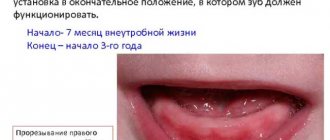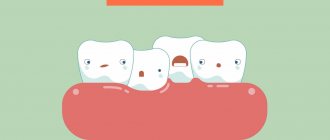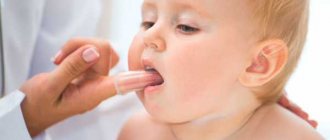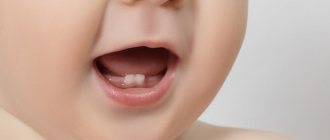The appearance of an infant’s first milk teeth is a difficult period for both him and his parents. The baby often cries, is capricious and demands increased attention from mom and dad. Teething is often accompanied by an increase in temperature. It lasts for 1-3 days, after which the child’s condition stabilizes.
Teething can be called a purely individual process. In some children it is completely asymptomatic, while in others very unpleasant symptoms appear that significantly worsen the baby’s life - diarrhea, hyperthermia, loss of appetite, inflammation of the gums and others. This clinical picture often confuses parents - they cannot understand whether these signs are related to teething or whether the child is developing some kind of pathology.
Parents' biggest concern during teething is temperature. It can rise to dangerous levels - 39-40°C. To alleviate the child’s condition, it is necessary to be able to provide him with first aid, as well as to recognize in time the signs indicating that you urgently need to either call an ambulance or go to the hospital yourself.
Why does the temperature rise
Teething is a traumatic process. Dental units damage the gum mucosa and inflammation occurs, which in medicine is called aseptic (microbial-free). This process is accompanied by an increase in temperature. In addition, during teething, some processes occur in the baby’s body that stimulate hyperthermia:
- at the site of localization of future milk teeth, specific substances necessary for softening the bone tissue of the jaw begin to be actively produced;
- Since all the forces of the child’s body are aimed at teething as quickly as possible, the immune system weakens a little. During this period, infectious agents present in the body may become active and diseases will begin to progress. Many of them are accompanied by an increase in temperature.
Damaged gums are the “entry gate” for infection. Through them, pathogenic microflora can penetrate the body and provoke the development of a septic inflammatory process. The body also responds to such an attack with an increase in temperature. To prevent infection, it is recommended to take more careful care of your baby’s gums during this difficult period for him. Pharmaceutical companies now produce many drugs that have a triple effect - relieve pain, reduce inflammation, fight viruses, bacteria and fungi. But before using these medications, it is recommended to consult your pediatrician.
Loss of baby teeth in children, replacement scheme with permanent ones
We all remember those sleepless nights when our dear little one was teething for the first time. Teething is a rather long and quite painful process. But everything turns out to be behind us around the age of 3, when your baby can boast of 20 bead-like teeth. These are temporary teeth, called milk teeth. Starting from the age of 6, they begin to fall out in order to make room for permanent ones. But this is a completely natural and painless process that should not frighten parents. Usually, baby teeth are replaced by permanent teeth around the age of 4 , when the child’s third molars begin to erupt.
It is this period that can be considered the beginning of the process of baby teeth falling out. We will consider below which teeth change in a child. In general, the process of losing baby teeth is quite long and can last from five to eight years . This period depends on:
- Genetics of the child
- Varieties of diet
- Quality of drinking water consumed
No matter how many milk teeth a child has, by the age of 13-14 they are completely replaced by permanent ones.
Teething symptoms
A child's first teeth begin to erupt between 4 and 8 months. There are exceptions. Sometimes children are born with several teeth, while others show them only after a year. Teething is a difficult process for a child. It can be accompanied by various symptoms, but the most common are the following:
- How long does it take for drugs to leave the body?
- Increased nervousness. The child cries for no reason, whines. Teething may be accompanied by painful sensations that prevent him from sleeping normally. As a result, the regime of wakefulness and rest is disrupted.
- Heavy salivation. This is a protective process. Saliva has anti-inflammatory and bactericidal properties. Hypersalivation helps protect inflamed gums from infection. Sometimes there is so much saliva that it flows down the chin onto the neck and chest. You should not constantly rub your baby's delicate skin. It is permissible to periodically carefully blot with dry wipes.
- Loose stools. During teething, the baby may experience diarrhea. It is caused by increased salivation, changes in intestinal microflora, or increased bacterial activity due to a decrease in the body's immune defense.
- Decreased appetite. Often, due to pain in the gums, infants refuse to eat. In this case, it is a little easier for those who are breastfed, since the sucking process calms and pacifies the baby.
- Inflammation of the gums. This is the natural state of affairs at the time of teething. If a white stripe appears in some place of the gum, the tooth will soon come out.
- Runny nose. Sometimes swelling and inflammation from the gums spreads to the nasal mucosa. As a result, the baby begins to snot.
- Itching in the gums. The baby puts all the objects that come to hand into his mouth. This is how he scratches his gums. To make his task easier, you can purchase special teething toys in stores.
- Hyperthermia. The temperature rises in 80% of cases. It is important to ensure that it does not reach critical levels. Once every 1-2 hours, it is recommended to measure it not with an electronic, but with a mercury thermometer, since it is more reliable.
All these symptoms frighten parents, as they are similar to the signs of many other diseases of the upper respiratory tract and gastrointestinal tract. These symptoms are typical for teething. But you need to monitor the baby’s condition very carefully, and if the clinic is accompanied by other alarming symptoms, you need to immediately contact your doctor.
Baby teeth in children
Mothers often ask: at what age should children take care of their teeth? And pediatric dentists answer: you should start before the child is born.
After all, temporary or, as they are called, milk teeth are formed during the period of intrauterine development of the baby. They are influenced by whether the mother had toxicosis or whether she has chronic diseases. But the main thing is whether the expectant mother has had her teeth treated and whether she has gum inflammation. Caries in a pregnant woman can lead to the development of caries in an infant, and diseased baby teeth will later lead to diseases of the main teeth.
Symptoms indicating pathology
An increase in temperature during teething is a natural process. This is a kind of protective reaction of the baby’s body. At this time, it is necessary to carefully assess the general condition of the child. Sometimes dangerous pathologies can be hidden behind teething syndrome. Therefore, parents should know the symptoms indicating the progression of the pathological process:
- Vomit. Single vomiting can occur at high temperatures. But if it recurs, the baby feels very bad and has diarrhea, you need to see a doctor as soon as possible. These are signs of intestinal infection or poisoning.
- Nasal congestion or discharge of thick yellow-green snot. This is not the norm, it is a pathology that requires adequate and immediate treatment.
- Coughing. During teething, a lot of saliva is released. Often children simply do not have time to swallow it, and they may choke. A cough appears reflexively, which is not pathological. But if wheezing is heard and a certain amount of sputum is released during coughing, this indicates the development of diseases of the upper respiratory tract (tracheitis, bronchitis and others).
- Stomach ache. With normal teething, this symptom should be absent. If the baby is restless, capricious, cries, or pulls his legs toward his stomach, these are alarming signs. Especially if the abdominal pain is accompanied by repeated vomiting. This symptom complex indicates the development of an intestinal infection. The child could pick it up through toys and other objects that he pulled into his mouth.
- Red throat. Swelling from the gums does not spread to the palate. It can spread to the nasal cavity. If the throat and palate are hyperemic (reddened) upon examination, this is the first sign of the development of pharyngitis.
If you have at least one of these symptoms, you should immediately contact your doctor or go to a medical facility. There the child will be examined by a pediatrician and prescribed the correct treatment. It is prohibited to give any medications (except antipyretics) at home without prior approval from the doctor.
How long does the temperature last
During teething, the temperature rises on average to 37.7°C. This has practically no effect on the general condition of the child. He is active, eats well, plays. But hyperthermia can also reach high numbers - 39-40°C. In this case, the baby is lethargic, capricious, and refuses to eat. It is better to take measurements every 1-2 hours. If the increase is critical, an antipyretic drug should be given. Normally, the temperature during teething can last up to three days. If hyperthermia is present even on the 4th day, you cannot do without the help of a doctor.
When to lower the temperature
There is no need to lower the temperature to 38.5°C. If it rises higher, you need to take action. Hyperthermia affects many processes in the human body. During fever, the water-salt balance is disrupted and the load on the heart increases. In severe cases, convulsions may occur that can lead to respiratory arrest. In no case should this be allowed to happen, as this would pose a threat not only to the health, but also to the life of the little patient.
- How many days does a baby's teething temperature last?
When to give antipyretic drugs:
- temperature exceeded 39°C;
- breathing rate increases;
- the baby sleeps for a very long time;
- the child is restless, cries, cannot calm down;
- drying of mucous membranes, redness of the skin;
- the occurrence of convulsions (in this case, they give an antipyretic and immediately call an ambulance).
If the child has already had convulsions once, the temperature must be brought down when it exceeds 38°C.
What can you do to bring down the temperature?
An increase in a child's temperature is always a reason for panic among his parents. But it is important to control yourself and be able to properly help your child. To normalize body temperature, you can resort to methods of traditional and folk medicine.
Medications
For young children, it is best to give the medicine in syrup form or use rectal suppositories. Both the baby and the older child will refuse to take the bitter pill, and giving it to him will be problematic. If you don’t have anything else at hand, then you can try mixing the medicine with something tasty - honey, fruit puree.
Medicines for fever in a child
To normalize a child's body temperature, medications based on paracetamol or ibuprofen are used in pediatrics. The first can be given to a baby from the first days of life, the second - from three months. Before use, you should consult with your doctor, and also study the instructions for the drug in detail, paying special attention to side effects and dosage.
Traditional methods
If you don’t have the required medications in your medicine cabinet at the right time, you can resort to traditional methods of lowering your temperature. They allow you to reduce the heat by 1-2 degrees. This is often enough to stabilize the child’s general condition.
Effective methods:
- Toothache and fever
- Physical cooling with a diaper or sheet. This method can hardly be called purely folk, since it is also used in medical institutions. Its essence is to cool the “burning” human body. It is necessary to wet the diaper in warm water and wrap it around the baby.
- Rubbing with warm water. It is necessary to prepare a sponge and a deep container with water. Her temperature should be 36-37 degrees. Water that is too cold can cause chills and even trigger cramps. Hot water will not bring the expected effect. Take a little warm water into a container, moisten a sponge in it and carefully wipe the child’s feet and hands, elbows and knees, and armpits.
- Cabbage leaves. They need to be kept in boiling water, and then beaten a little, cooled and applied to the baby’s body.
- Linden blossom. It can be given even to children under one year old. It has a pronounced diaphoretic effect. As a result, the child sweats and body temperature decreases. Use after consultation with a specialist and in the absence of an allergic reaction to this plant.
It is best to use traditional methods of treatment in tandem with traditional ones. This will not only achieve the desired effect, but also quickly improve the child’s condition.
Complications after prosthetics
- The development of inflammation of the gingival tissue - as a result, leads to gingivitis, stomatitis in acute and chronic forms. As a rule, such a complication in the oral cavity occurs due to poor fit of the tooth replacement structure. The process goes like this: the structure puts pressure on the tissue, blood vessels die, there is no blood supply to the tissue, and inflammation develops.
- Carious formations - as a result, the supporting teeth are affected by pulpitis or periodontitis. This usually occurs due to the accumulation of food debris between the prosthetic structure and living tissues. The problem leads to the fact that the teeth are gradually destroyed, cease to perform their supporting functions, and the fixation of the prosthesis is disrupted.
- Infectious lesions of soft and bone tissues – periodontitis. Often obvious destructive changes are noticeable around the product: the gums acquire a bluish tint, swelling and bleeding of the tissue develops. As a result, this leads to tooth loss and disruption of the fixation of the replacement structure.
- Rejection of the structure due to an allergic reaction. It can manifest itself as swelling of the gums, itching, rash and redness in the mouth. In some cases, difficulty breathing and a constant feeling of dry mouth and fever may occur. Allergies may appear in the first few hours after installation of the structure or after several weeks.
- The development of galvanism leads to the generation of galvanic current. What usually happens when using structures with a metal frame is that saliva gets on the material, the patient feels a taste of iron in the mouth, a constant feeling of an acidic environment in the oral cavity, and discomfort. As a result, the crowns darken, aesthetics are impaired, and sometimes the problem is accompanied by a headache.
- Poor quality fixation of the product. As a rule, the product “sits” on a special dental cement, which does not always hold the product in the oral cavity. The prosthesis may come off due to overload, incorrectly selected shape or size of the prosthesis. It is also possible that the dentist did not use enough dental cement for bonding. Sometimes fillings on the teeth prevent the prosthesis from “adhering” to living tissue.
- Product deformation. These can be chips, cracks, breaks, breaks into halves or small parts. The denture can become deformed due to impacts to the jaw projection, accidents, falls, or eating too hard foods. Sometimes the product is deformed due to errors in prosthetic planning.
- Problems with the occlusal plane. We are mainly talking about the surface that passes through the cutting edges of the first incisors of the lower jaw and the tubercles of wisdom teeth or second molars. The plane may shift, causing the temporomandibular joint to suffer.
- Change in bite. The height of dental crowns plays a big role. For example, with a lack of height, the quality of chewing decreases - a low-quality food bolus is formed. When the height of the crowns is high, the jaw is overloaded, which provokes dysfunction of the temporomandibular joint.
How to solve a problem?
The dentist recommends treating the oral cavity with antiseptic solutions, as well as special gels to activate tissue regeneration processes. With regular treatment and oral care, the gums are soothed.
How to solve a problem?
At least twice a year (or even more often) undergo a full examination by a dentist. Not a single prosthesis, even a well-made one, will stand in such a way that bacteria will not accumulate under it. Care for the cavity with such products should be twice as thorough as usual!
How to solve a problem?
First, the dentist must prepare the teeth without creating so-called ledges. Secondly, the design must be selected strictly; several fittings and adjustments of the product may be required. Thirdly, before installing a prosthetic product, it is necessary to treat the gums. Regular therapy may be needed to maintain the health of the oral soft tissues.
How to solve a problem?
It is necessary to establish which component of the prosthetic structure the patient is allergic to. Most likely, the prosthesis will have to be replaced. That is why, at the stage of planning prosthetics, it is important to study the medical history and make sure that the patient does not have an allergy to metal.
How to solve a problem?
Replace the prosthesis with a product made of ceramic material. When installing ceramic structures, galvanism does not occur.
How to solve a problem?
Determine exactly why the prosthesis is poorly fixed and perform re-fixation with correction of inaccuracies.
How to solve a problem?
If the deformation is minor, the structure can be repaired directly in the oral cavity. Sometimes removal and re-fixation may be necessary. If the damage is serious, the prosthesis will have to be removed and a new one put in its place.
How to solve?
Since the problem is global, most likely, it is necessary to re-plan the prosthetics with a thorough diagnosis of the bite and the production of a new prosthetic structure.
How to solve a problem?
Determine the main cause of the development of malocclusion, re-plan prosthetics with replacement of the structure.
What not to do when teething
It’s hard to look at a child when you know that he’s feeling bad right now. Therefore, many parents try to take some measures to somehow help their child. But not everything goes to his advantage. During the teething period, you cannot rush the course of events. Teeth will erupt in any case. If you try to speed up this process, you can only do harm.
What not to do:
- give adult medications to bring down the temperature;
- wipe the child with vinegar or alcohol;
- massage the gums;
- make cuts on the gum so that the tooth emerges faster;
- give the child dry bread crust (it can scratch the swollen tissues in the mouth and infection can penetrate through the wounds).
Now in children's stores there are a sufficient number of various “rodent” toys, as well as pain-relieving gels that will help simplify the teething process and reduce pain and inflammation. It is to them that you need to resort if there is a need to help the baby.
“Rodents” for teething children
Reasons for delayed hair loss
You may encounter a situation where the loss is slightly delayed . This may be due to the child’s heredity, rickets, or a consequence of an infectious disease.
“Shark teeth” is a situation where a baby tooth becomes loose but does not fall off. And in parallel with this, a constant grows. That is, it turns out that the teeth grow in two rows, like those of sharks. But this process is not so scary. Baby teeth eventually fall out, and permanent teeth gradually take their “rightful place.” But if it has not fallen out within 3 months, then you should consult a pediatric dentist.










